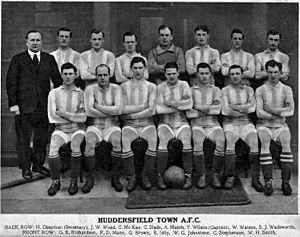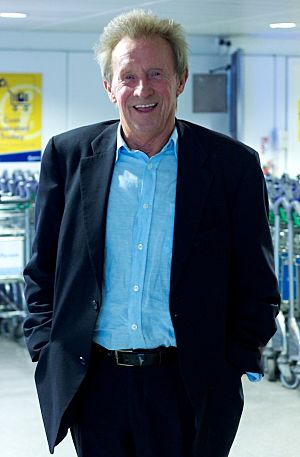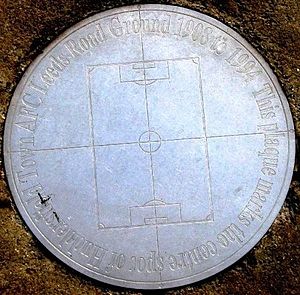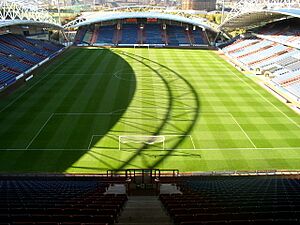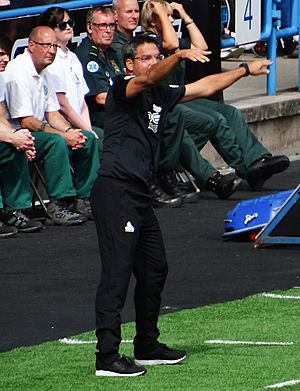History of Huddersfield Town A.F.C. facts for kids
The history of Huddersfield Town A.F.C., an English football club from Huddersfield, West Yorkshire, began in 1908. In 1926, Huddersfield became the first club to win three English League titles in a row. Only three other clubs have ever done this. They also won the FA Cup in 1922 and were runners-up four other times.
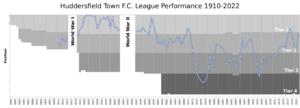
Contents
How Huddersfield Town Started (1908–1912)
In 1908, the club was formed in a pub called the Albert Pub in Huddersfield. A company was set up to buy the Leeds Road recreation fields. This became the club's first stadium.
On 15 August 1908, Huddersfield Town Association Football Club officially became a company. Fred Walker was the club's first manager. The stadium opened on 2 September with a game against Bradford Park Avenue. Huddersfield won 2–1 in front of 1,000 fans. Their first official match was three days later against South Shields Adelaide.
In 1910, Huddersfield wanted to join The Football League. They planned to rebuild Leeds Road to hold 34,000 fans. After these plans, Huddersfield successfully joined the Football League. The stadium was finished a year later and officially opened on 2 September 1911. However, the club faced big debts and went out of business in 1912. Town continued to play until 1915 when the League stopped for World War One.
The Golden Days (1919–1945)
In 1919, Huddersfield Town was in debt. There was a plan to move the club to Leeds. But supporters raised money to keep the club in Huddersfield. After this, Huddersfield Town reached the 1920 FA Cup Final and was promoted to Division One for the first time.
During their first season in the top league, Herbert Chapman became the new manager. He helped the team avoid relegation. Chapman brought in players like Clem Stephenson and George "Bomber" Brown. He used a new tactic called the W-M formation. This style focused on strong defence and quick counter-attacks. Chapman is known as the first manager to use the counter-attack successfully. He also made sure youth teams played the same way as the main team.
In Chapman's first full season, Town won their first major trophy. They beat Preston North End 1–0 to win the FA Cup. Billy Smith scored the only goal. Huddersfield also won the Charity Shield that year. Chapman then signed more key players like goalkeeper Ted Taylor. Town finished third in the league in 1922–23.
The next season, Huddersfield became champions of England for the first time. They won the title by a tiny difference in goal average. This showed how important every goal was.
During these successful years, more fans came to watch. The Leeds Road stadium was made bigger. It could hold 47,000 fans for a cup game and later grew to 60,000.
The 1924–25 season started well. Town won the league title again, only losing one more game in the last 27 matches. They only let in 28 goals all season, which was a first for any team. In October 1924, Billy Smith became the first player to score directly from a corner kick. After winning two league titles in a row, Herbert Chapman left to manage Arsenal.
Cecil Potter took over as manager. Huddersfield then won a historic third league title in a row in 1925–26. This is a record that no other club has broken since.
Town almost won a fourth title in 1926–27. But they failed to win their last three matches, giving the title to Newcastle United. In 1927–28, Town finished second in both the league and the FA Cup. George Brown was Town's top scorer with 35 goals.
In March 1928, five Town players played in an international match between England and Scotland at Wembley. Alex Jackson scored three goals for Scotland as they beat England 5–1.
The team grew older, and new players were not brought in well. Town reached two more FA Cup finals under manager Clem Stephenson. They lost to Arsenal in 1930 and to Preston in 1938. Stephenson was Huddersfield's longest-serving manager. He also saw Town's biggest win, a 10–1 victory over Blackpool in December 1930.
After World War II (1945–1970)
Huddersfield Town stayed in the top division until 1950. A fire at Leeds Road forced them to play two games at Leeds United's stadium. In 1951–52, Huddersfield was relegated for the first time. Andy Beattie became manager. He signed important players like Ron Staniforth and Jimmy Watson. Town finished runners-up in Division Two and returned to the top league right away.
After returning, Huddersfield finished third in the top division. This is their highest finish since World War II. The next season, they finished 12th. Beattie resigned in November 1956, and Bill Shankly became manager.
In 1957–58, Shankly's team lost 7–6 to Charlton Athletic, even after being 5–1 up. Shankly left in 1959 to manage Liverpool. Floodlights were put in at Leeds Road in 1961. This was paid for by the sale of Denis Law to Manchester City.
Huddersfield returned to the first division in 1970 under manager Ian Greaves. They finished 15th in their first season back.
A Difficult Period (1970–1978)
In their second season in Division One, Huddersfield was relegated in 1972. Key players like Trevor Cherry and Frank Worthington left. This led to a second relegation to Division Three. This was the first time Town played in the third tier. Manager Ian Greaves resigned.
Bobby Collins took over but led the club to another relegation. In 1975, Huddersfield became the first league champions to drop into Division Four. Tom Johnston returned as manager and helped the team finish fifth. However, Town reached their lowest-ever league position of 11th in 1977–78.
Getting Back on Track (1978–1993)
A recovery began under Mick Buxton, who became manager in 1978. Buxton made the team train harder and brought in new players. In 1979–80, Town won the Fourth Division Championship, scoring 101 goals. Buxton also won Manager of the Year.
Buxton led the team to promotion to the Second Division in 1983. Town struggled in the following seasons due to a lack of money. Buxton was sacked in 1986. Steve Smith became manager and saved the club from relegation.
The 1987–88 season was Town's worst ever. They lost 10–1 to Manchester City and were relegated back to Division Three. Malcolm Macdonald was sacked and replaced by Eoin Hand.
Ian Ross took over in 1992. He led the Terriers to a third-place finish and a Play-off game against Peterborough United. Town lost the play-off, which was a big disappointment.
New Stadium and Tough Times (1993–2008)
Neil Warnock became manager for the 1993–94 season. He signed new players like Ronnie Jepson. Town had a good run in the Football League Trophy and reached the final at Wembley. This was Huddersfield's first Wembley appearance since 1938. The team lost the final on penalties but finished the league season strongly.
Huddersfield Town played their last game at Leeds Road on 30 April 1994. They moved into the new Alfred McAlpine Stadium (now called the John Smith's Stadium) for the 1994–95 season. In their first season at the new stadium, Huddersfield was promoted through the play-offs.
Brian Horton became manager in 1995. Town finished 8th in Division One. Horton was sacked in 1997. Former player Peter Jackson took over. He helped the team avoid relegation in a season known as the Great Escape.
In 1998–99, Town started well but then lost form. Jackson was sacked. Steve Bruce became manager in 1999. Town started the 1999–2000 season strongly, even topping the division at Christmas. But poor form continued into 2000. Bruce was sacked in October 2000.
Lou Macari replaced Bruce. Town was relegated back to the third tier. Macari was replaced by Mick Wadsworth. The 2002–03 season was very difficult. The club had huge debts, and players and staff were not paid. Wadsworth was eventually sacked, and Town was relegated again.
Peter Jackson returned as manager in 2003–04. Ken Davy bought the club and saved it from going out of business. Jackson built a new team with young players. Town had a great run and reached the play-offs. They beat Mansfield Town in the Play-off final to get promoted.
The 2004–05 season was called "The Young Guns" season. Town finished strongly, just missing out on the play-offs. In 2005–06, Town started well and were even top of the division. They reached the play-offs but lost to Barnsley.
Jackson was sacked in 2007. Andy Ritchie took over but only lasted a year. Stan Ternent was appointed in April 2008. He was sacked after only 15 league games in charge.
Reaching the Premier League (2008–Present)
Lee Clark became manager in December 2008. He led Town to the play-offs in his first full season, but they lost to Millwall.
In 2010–11, Town finished third in the table. They reached the play-off final but lost to Peterborough United. The team then set a Football League record of 43 games unbeaten. This run ended against Charlton Athletic.
Clark was sacked in February 2012. Simon Grayson took over. On 26 May 2012, Grayson led Town to the League One play-off final. The game went to a penalty shootout, and Huddersfield won 8–7, getting promoted to the Championship.
After a good start to the 2012–13 season, Town had a bad run. Grayson was sacked. Mark Robins took over and helped Huddersfield avoid relegation. In November 2015, David Wagner became the first foreign manager of Huddersfield Town. He wanted his team to play a fast, attacking style of football.
At the start of the 2016–17 season, many people thought Town would be relegated. But they surprised everyone by getting promoted to the Premier League for the 2017–18 season through the play-offs. This was their first time in the top league since 1971–72.
The Terriers again defied expectations in the Premier League. They finished 16th and stayed up for another season. A big highlight was their 2–1 home win against Manchester United.
However, Town struggled in the next season. They had a ten-match winless start. Wagner left the club in January 2019 and Jan Siewert took over. Town's relegation was confirmed on 30 March 2019.
Dean Hoyle resigned as chairman in May 2019 due to illness. Phil Hodgkinson replaced him. Town finished the season with some strong draws, preparing for their return to the Championship.


